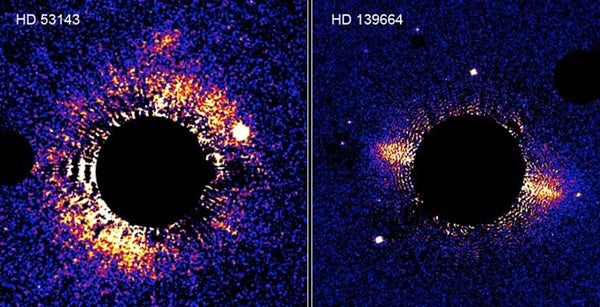The Kuiper Belt is a disk-shape region beyond Neptune’s orbit that hosts a multitude of icy rocks. Images from the Hubble Space Telescope (HST) indicate that a stellar duo boasts similar debris disks.
Over a 2-year period that ended in 2004, a team of astronomers used HST to image 22 stars. Wide and narrow belts encircle two of these bodies, HD 53143 and HD 139664. Both stars lie about 60 light-years from Earth. Astronomers now know of nine of these dusty disks, including the Kuiper Belt, observable at visible wavelengths.
These newly discovered dusty disks are older than most of the other known belts. At 300 million years old, they have settled into planet-to-debris relationships similar to our solar system. The others, excluding our Sun, range from tens of millions to 200 million years old.
“These are the oldest debris disks seen in reflected light, and are important because they show what the Kuiper Belt might look like from the outside,” explains research leader Paul Kalas of the University of California, Berkeley. “These are the types of stars around which you would expect to find habitable zones and planets that could develop life. Ironically, our own debris disk is the closest, yet we know the least about it.”
The central areas of these stellar disks appear to be clear of concentrated debris. Planets may be responsible for creating these sharp, inner edges.
Kalas told Astronomy the driving force behind this study came from Infrared Astronomical Satellite observations from the mid-1980s. These observations discovered, but did not resolve, the reflected light from interstellar dust grains.
Debris disks usually are difficult to image due to the central star’s glare. HST’s Advanced Camera for Surveys made it possible to look for disks after blocking the star’s light. The survey was the first of its kind to utilize the camera’s coronagraphic mode, which was installed on Hubble during the last serving mission in 2002.
The group’s findings appeared in the January 20 issue of the Astrophysical Journal Letters.










